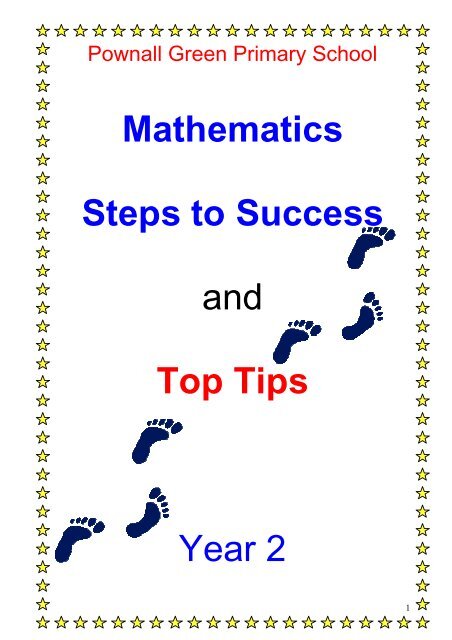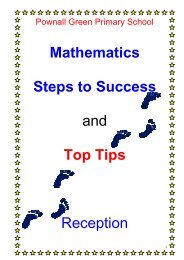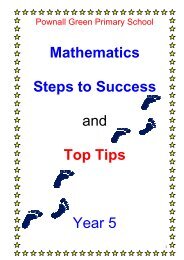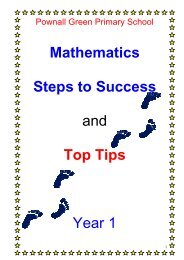Mathematics Steps to Success and Top Tips Year 2 - Pownall Green ...
Mathematics Steps to Success and Top Tips Year 2 - Pownall Green ...
Mathematics Steps to Success and Top Tips Year 2 - Pownall Green ...
Create successful ePaper yourself
Turn your PDF publications into a flip-book with our unique Google optimized e-Paper software.
<strong>Pownall</strong> <strong>Green</strong> Primary School<br />
<strong>Mathematics</strong><br />
<strong>Steps</strong> <strong>to</strong> <strong>Success</strong><br />
<strong>and</strong><br />
<strong>Top</strong> <strong>Tips</strong><br />
<strong>Year</strong> 2<br />
1
Contents<br />
1. Count, read, write <strong>and</strong> order whole numbers <strong>to</strong> at least 100 3<br />
2. Know what each digit represents (including 0 as a place holder) 3<br />
3. Describe <strong>and</strong> carry on number sequences (including odd/even<br />
numbers, counting on or back in ones or tens from any two<br />
digit number, <strong>and</strong> so on) 3<br />
4. Underst<strong>and</strong> that subtraction is the inverse of addition 3<br />
5. Say the subtraction calculation <strong>to</strong> a given addition <strong>and</strong> vice versa 4<br />
6. Know all addition <strong>and</strong> subtraction facts for each number <strong>to</strong> 10 4<br />
7. Know that addition can be done in any order <strong>and</strong> use this <strong>to</strong> help<br />
with mental calculation 4<br />
8. Know that multiplication is repeated addition 4<br />
9. To half numbers because I know halving is the inverse of doubling 5<br />
10. Know by heart facts for the 2 multiplication table 5<br />
11. Know by heart the facts for the 10 multiplication table 5<br />
12. Know which operations <strong>to</strong> use when solving problems 5<br />
13. Estimate, measure <strong>and</strong> compare lengths using st<strong>and</strong>ard units 6<br />
14. Estimate, measure <strong>and</strong> compare masses using st<strong>and</strong>ard units 6<br />
15. Estimate, measure <strong>and</strong> compare capacities using st<strong>and</strong>ard units 6<br />
16. Read a simple scale <strong>and</strong> use a ruler <strong>to</strong> draw <strong>and</strong> measure lines<br />
<strong>to</strong> the nearest centimetre 7<br />
17. Use the mathematical names for common 2-D <strong>and</strong> <strong>to</strong> sort shapes<br />
<strong>and</strong> describe some of their features 7<br />
18. Use the mathematical names for common 3-D <strong>and</strong> <strong>to</strong> sort shapes<br />
<strong>and</strong> describe some of their features 8<br />
19. Use mathematical vocabulary <strong>to</strong> describe position, direction <strong>and</strong><br />
movement 8<br />
Page<br />
2
<strong>Steps</strong> <strong>to</strong> <strong>Success</strong> <strong>and</strong> <strong>Top</strong> <strong>Tips</strong>– <strong>Year</strong> 2<br />
Key Learning Objectives<br />
1.To count, read, write <strong>and</strong> order whole numbers <strong>to</strong> at least 100<br />
<strong>Steps</strong> <strong>to</strong> <strong>Success</strong><br />
1. Sort the numbers according <strong>to</strong> how many tens they have.<br />
2. Within each set of ten order the units.<br />
<strong>Top</strong> <strong>Tips</strong><br />
• Read the numbers carefully (reading from left <strong>to</strong> right, identifying<br />
which are the tens <strong>and</strong> which are the ones.)<br />
• How many digits does it have?<br />
• What is each digit worth?<br />
• Remember when writing a number we write it left <strong>to</strong> right –<br />
demonstrate what happens <strong>to</strong> the value of numbers when we write<br />
right <strong>to</strong> left.<br />
2.To know what each digit represents (including 0 as a place holder).<br />
<strong>Top</strong> <strong>Tips</strong><br />
• Write the place value column headings <strong>to</strong> help.<br />
• Use arrow cards <strong>to</strong> demonstrate 0 as a place holder.<br />
• Use 10p’s <strong>and</strong> 1p’s<br />
3.To describe <strong>and</strong> carry on number sequences (including odd/even<br />
numbers, counting on or back in ones or tens from any two-digit<br />
number, <strong>and</strong> so on).<br />
<strong>Steps</strong> <strong>to</strong> <strong>Success</strong><br />
1. Look carefully at the number sequence.<br />
2. Can you see a pattern? What is happening each time?<br />
3. Test your idea on the sequence <strong>to</strong> check that you are correct.<br />
4.To underst<strong>and</strong> that subtraction is the inverse of addition<br />
<strong>Top</strong> <strong>Tips</strong><br />
• Demonstrate the corresponding addition <strong>to</strong> the subtraction using<br />
objects. Make the relationship between + <strong>and</strong> – explicit.<br />
• Use a number balance.<br />
3
5.To say the subtraction calculation <strong>to</strong> a given addition <strong>and</strong> vice<br />
versa<br />
<strong>Top</strong> <strong>Tips</strong><br />
• Start with the answer <strong>to</strong> the addition calculation.<br />
• Use Number Trios or number balance or child held numbers<br />
6.To know all addition <strong>and</strong> subtraction facts for each number <strong>to</strong> 10<br />
<strong>Top</strong> <strong>Tips</strong><br />
1. Begin using ten fingers.<br />
2. Use 10 pegs on a coat hanger, hide a set <strong>and</strong> ask how many<br />
hidden?<br />
3. Mental recall.<br />
4. Recite from memory.<br />
7.To know that addition can be done in any order <strong>and</strong> use this <strong>to</strong> help<br />
with mental calculations<br />
<strong>Steps</strong> <strong>to</strong> <strong>Success</strong><br />
<strong>Top</strong> <strong>Tips</strong><br />
1. Put the biggest number in your head<br />
2. Count on from the biggest number<br />
• Remember that addition can be done in any order, but beginning<br />
with the biggest number is easier.<br />
• Put up the number of fingers you want <strong>to</strong> add <strong>to</strong> the biggest<br />
number FIRST <strong>and</strong> then put each finger down as you count on.<br />
• Addition of three numbers – look for number bonds <strong>to</strong> 10, near<br />
bonds, doubles <strong>and</strong> near doubles.<br />
8.To know that multiplication is repeated addition<br />
<strong>Top</strong> <strong>Tips</strong><br />
1. Demonstrate using cubes/sets of <strong>to</strong>ys, children, money etc<br />
2. 4 x 5 = 5 + 5 + 5 + 5<br />
3. Explain that multiplication is a quick way of adding the same<br />
number again <strong>and</strong> again.<br />
4. Draw arrays (groups of dots) <strong>to</strong> represent a multiplication.<br />
4
9. To half numbers because I know halving is the inverse of doubling<br />
<strong>Top</strong> <strong>Tips</strong><br />
• Use cubes – demonstrate doubling <strong>and</strong> halving.<br />
• Use real life examples e.g. pizza<br />
10.To know by heart facts for the 2 multiplication table<br />
<strong>Steps</strong> <strong>to</strong> <strong>Success</strong><br />
1. Using fingers <strong>to</strong> mark number of sets.<br />
2. Read the multiplication facts whilst reciting.<br />
<strong>Top</strong> <strong>Tips</strong><br />
• Make explicit that the multiples of 2 are EVEN numbers.<br />
• Look at the repeated pattern of units 0, 2, 4, 6, 8 etc.<br />
11.To know by heart the facts for the 10 multiplication table<br />
<strong>Steps</strong> <strong>to</strong> <strong>Success</strong><br />
1. Using fingers <strong>to</strong> mark number of sets.<br />
2. Read the multiplication facts whilst reciting.<br />
<strong>Top</strong>s <strong>Tips</strong><br />
• Make explicit that the multiples of 10 end in 0<br />
• Look for patterns on the 100 square<br />
12.To know which operations <strong>to</strong> use when solving problems<br />
<strong>Steps</strong> <strong>to</strong> <strong>Success</strong><br />
Read <strong>and</strong> underst<strong>and</strong> the problem.<br />
Underline key information.<br />
Decide what you need <strong>to</strong> work out.<br />
Estimate<br />
Calculate<br />
Answer in a sentence<br />
Take time <strong>to</strong> check your answer<br />
<strong>Top</strong> <strong>Tips</strong><br />
Identification of language used<br />
5
<strong>Steps</strong> <strong>to</strong> <strong>Success</strong> <strong>and</strong> <strong>Top</strong> <strong>Tips</strong><br />
Shape, Space <strong>and</strong> Measures – <strong>Year</strong> 2<br />
Key Learning Objectives<br />
13. To estimate, measure <strong>and</strong> compare lengths using st<strong>and</strong>ard<br />
units<br />
<strong>Top</strong> <strong>Tips</strong><br />
• Discuss the importance of st<strong>and</strong>ard units<br />
• Use a metre stick: make comparison- longer than/shorter than.<br />
• Make links with familiar classroom objects e.g. length of the<br />
desk is about 1m/a child<br />
• Make clear that the metre is the base unit of length.<br />
Underst<strong>and</strong>ing the size of the base unit will help underst<strong>and</strong><br />
the size of all other units.<br />
• There are smaller units such as centimetres which are 100<br />
times smaller than the metre (centi = 1/100)<br />
• 1 cm is approximately the width of a child’s finger.<br />
• Discuss which unit you would use <strong>to</strong> measure different objects<br />
e.g. a door, a pencil etc.<br />
14. To estimate, measure <strong>and</strong> compare masses using st<strong>and</strong>ard<br />
units<br />
<strong>Top</strong> <strong>Tips</strong><br />
• Introduce 1kg <strong>and</strong> g as st<strong>and</strong>ard units for mass.<br />
• Sort objects in<strong>to</strong> more or less than 1kg.<br />
• Make links with familiar objects e.g. food packaging<br />
• Make clear that the gram is the base unit of mass.<br />
Underst<strong>and</strong>ing the size of the base unit will help underst<strong>and</strong><br />
the size of all other units.<br />
• There are larger units such as kilogram which are 1000 times<br />
larger than a gram (kilo=1000). Link <strong>to</strong> children’s own weight.<br />
15. To estimate, measure <strong>and</strong> compare capacities using st<strong>and</strong>ard<br />
units<br />
<strong>Top</strong> <strong>Tips</strong><br />
• Make links with familiar objects e.g. volume of a water bottle/<br />
soft drink bottle.<br />
• Make clear that the litre is the base unit of volume/capacity.<br />
Underst<strong>and</strong>ing the size of the base unit will help underst<strong>and</strong><br />
the size of all other units.<br />
• There are smaller units such as millilitres which are 1000 times<br />
smaller than the metre (milli = 1/1000)<br />
• Discuss when reading a scale in measuring <strong>and</strong> baking.<br />
6
16. To read a simple scale <strong>and</strong> <strong>to</strong> use a ruler <strong>to</strong> draw <strong>and</strong> measure<br />
lines <strong>to</strong> the nearest centimetre<br />
<strong>Steps</strong> <strong>to</strong> <strong>Success</strong><br />
1. Ensure that you have the cm side <strong>and</strong> not the mm side of the<br />
ruler.<br />
2. Place the Zero end of your rule at the end of your object,<br />
usually on the left side.<br />
3. Make sure the end of the ruler is flush with your object, <strong>and</strong><br />
use your left h<strong>and</strong> <strong>to</strong> hold it in place.<br />
4. Move <strong>to</strong> the opposite side of the object you are measuring,<br />
5. Read the last number on your rule that is alongside the object.<br />
This will indicate the "whole unit" length of the object.<br />
17. To use the mathematical names for common 2-D <strong>and</strong> <strong>to</strong> sort<br />
shapes <strong>and</strong> describe some of their features<br />
<strong>Top</strong> <strong>Tips</strong><br />
• Use the vocabulary: shape, flat, straight, curved, round,<br />
corner, side, edge, sort, circle, triangle, rectangle, square,<br />
pentagon, hexagon, octagon, circular, triangular, rectangular.<br />
• Feel a shape in a bag <strong>and</strong> name it.<br />
• Talk about the shapes <strong>and</strong> patterns in their environment <strong>and</strong><br />
take digital pho<strong>to</strong>s<br />
• Choose a shape <strong>to</strong> match the properties described by the adult<br />
<strong>and</strong> name it:<br />
• Refer <strong>to</strong> the properties of shapes such as the number of<br />
corners <strong>and</strong> sides<br />
• Programme the robot <strong>to</strong> draw squares <strong>and</strong> rectangles<br />
• Refer <strong>to</strong> properties such as: reflective symmetry<br />
• Fold 2D shapes along lines of symmetry.<br />
• Draw lines of symmetry on 2-D shapes.<br />
• Use mirrors <strong>to</strong> identify lines of symmetry.<br />
• Practice making symmetrical shapes by cutting <strong>and</strong> folding.<br />
7
18. To use the mathematical names for common 3-D <strong>and</strong> <strong>to</strong> sort<br />
shapes <strong>and</strong> describe some of their features<br />
<strong>Top</strong> <strong>Tips</strong><br />
• Use the terms: shape, solid, hollow, edge, face, straight,<br />
curved, point, corner<br />
• Focus on following shapes: Cube, Cuboid, Sphere, Cylinder,<br />
Cone , Pyramid<br />
• Describe the shape of the faces, the number of faces, edges<br />
<strong>and</strong> corners.<br />
• Sort 3-D shapes in different ways according <strong>to</strong> their properties<br />
of their faces<br />
• Make <strong>and</strong> describe shape patterns using solid shapes.<br />
• Relate solid shapes <strong>to</strong> pictures of them.<br />
• Identify solid shapes in the environment.<br />
• Discuss why some solid shapes are used as packages <strong>and</strong><br />
why others are rarely used.<br />
• Open 3D shapes <strong>to</strong> explore the nets.<br />
• Make 3D shapes.<br />
For high ability children<br />
• Read <strong>and</strong> use the terms ‘vertex’ <strong>and</strong> ‘vertices’<br />
• Know that a prism has the same cross section along its length<br />
<strong>and</strong> that the two end faces are identical<br />
• Collect examples of prisms <strong>and</strong> cylinders <strong>and</strong> match them <strong>to</strong><br />
name labels.<br />
• Name <strong>and</strong> describe solids e.g. a triangular prism.<br />
19. To use mathematical vocabulary <strong>to</strong> describe position, direction<br />
<strong>and</strong> movement<br />
<strong>Top</strong> <strong>Tips</strong><br />
Revise language: between across through backwards<br />
forwards sideways opposite underneath centre journey<br />
turn whole turn half turn<br />
Introduce vocabulary:<br />
clockwise anticlockwise quarter turn right angle straight line<br />
• Play robots – child <strong>to</strong> read direction cards- other children <strong>to</strong><br />
confirm the movement.<br />
8







